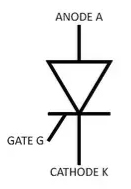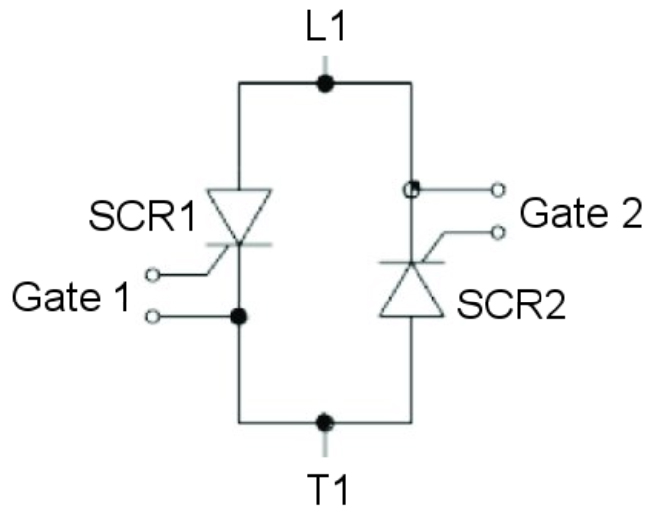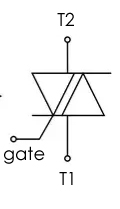Blog - EXPERTISES & INNOVATIONS - Relais statiques - Thyristor vs Triac
AC switching solid state relays use back-to-back Thyristors and TRIAC’s as their built-in output switching device. What is the difference between Triacs and Thyristors ?

Thyristor also called SCR stands for Silicon Controlled Rectifier.
It is a semiconductor switching device, with two power terminals, called the anode (A) and cathode (K) and one control terminal called the gate (G).
As a diode, the current can only flow through one direction, from Anode to Cathode. To operate on AC mains, the solution is therefore to use 2 SCR connected back to back:

The triggering of the thyristor is done by applying a current pulse positively circulating from Gate to Cathode
The latching of the Thyristor (to switch Thyristor to on-state condition) after a gate current pulse can only occur since :
– Anode-to-Cathode voltage is positive
– Anode-to-Cathode current after trigger exceed the Latching Current.
With the conditions above, the thyristor remains ON even without any current in the gate (Memory effect).
The latch can be reset (Thyristor turns OFF) in 2 cases :
– since Anode-to-cathode current drops below Holding Current
– Since Anode-to-Cathode voltage becomes negative

TRIAC stands for TRIode for Alternating Current.
Although it has the same triggering and latching behavior compared to a thyristor, it differs in that it can be triggered into conduction in both voltage/current directions, in response to a positive or negative gate signal.
Because they are semiconductor devices they cannot ensure a galvanic insulation when they are not controlled. They can even have a dangerous leakage current at OFF state. Furthermore the breakdown often leads to their short-circuit letting the current flow to the load.
This is an important aspect that must be considered to ensure safety in the system design in case of failure or maintenance: The user must ensure the possibility to galvanic isolate the SSR and load part of the circuit with a contactor or a MCB.
Triacs are based on a single silicon chip whereas back-to-back SCR are 2 separated silicon chips.
This physical difference plays a role in terms of current switching capability:
For load currents up to 25A, triac is a good and easy available solution
From 25A and beyond, back-to-back SCR is the best alternative to ensure high power switching capability.
Should you have any question, please feel free to contact our technical & sales team.